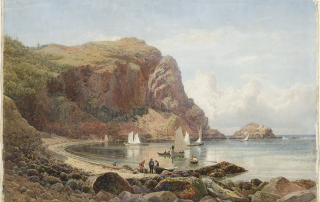Project Description
Sunrise on the Saguenay, Cape Trinity
Saguenay River, Quebec
Lucius O’Brien, 1880
National Gallery of Canada, 113
Medium: Oil on canvas | Genre: Landscape | Painting Style: Romanticism, Luminism
THE ART
When viewing Lucius O’Brien’s Sunrise on the Saguenay, Cape Trinity, the first quality that strikes you is the execution of light in the painting: it seems to hang in the air and has a physical presence apart from the landscape it illuminates.
O’Brien’s tendency towards strong and deliberate compositions can be seen in this painting. The curved shoreline frames the picture, giving it a foreground that amplifies the depth in the work.
The contrast between the mass of stone and the void of sky dramatizes the landscape. As well the strong verticality of the cliffs is accentuated by the near straight line of the distant shoreline.
The influence of artists such as Albert Bierstadt can be seen in the monumental geology, wrapped and diffused with a warm, moist light. O’Brien’s choice of colours used in the sky lends the painting a glowing quality, as if it’s emitting light.
Additional American influences can be seen in the choice of a maritime subject and in O’Brien’s desire to render the work in a highly finished fashion. His earlier work adhered to naturalism, which by this time had given way to ideals of distilled nature, perfected and arranged by the artist’s hand.
Not only is this O’Brien’s most famous work but it’s one of the first paintings acquired by the National Gallery of Canada. O’Brien’s lifelong artistic pursuit of the picturesque, sublime and beautiful is evident here. Avoiding deeper levels of meaning O’Brien wanted to create work “for the eye seeking rest and beauty,” an admirable goal.


 Lucius O’Brien
Lucius O’Brien




